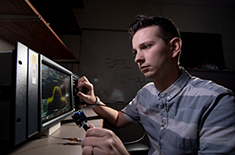Wi-Fi with Longer Range
October 25, 2019

Former University of Utah School of Computing graduate student, Phil Lundrigan, has created a software-based protocol that greatly extends the range of Wi-Fi signals. With it, devices such as Wi-Fi routers could extend their range by as much as 67 meters.
Lundrigan’s research, advised and co-authored by U School of Computing professor Sneha Kasera and electrical and computer engineering adjunct professor Neal Patwari (now at Washington University in St. Louis), was presented Oct. 22 at the ACM MobiCom Conference 2019, the 25th International Conference on Mobile Computing and Networking.
Lundrigan is currently an assistant professor of computer engineering at Brigham Young University.
Here is a BYU press release about the research.
A group of researchers led by a Brigham Young University computer engineering professor has created a protocol that significantly extends the distance a Wi-Fi-enabled device can send and receive signals.
The engineering innovation requires no new hardware to enhance the signal range for “internet of things” devices, like a door sensor or motion detector, but can extend the distance these devices can be installed from a Wi-Fi access point by more than 60 meters, according to test results.
“That’s the really cool thing about this technology: it’s all done in software,” said Phil Lundrigan, assistant professor of computer engineering at BYU. “In theory, we could install this on almost any Wi-Fi-enabled device with a simple software update.”
The new protocol is called On-Off Noise Power Communication and is programmed right on top of the existing Wi-Fi protocol using the same hardware. While Wi-Fi requires speeds of at least one megabit per second (1 Mbps) to maintain a signal, the “ONPC” protocol Lundrigan and his co-authors created can maintain a signal on as low as 1 bit per second — one millionth of the data speed required by Wi-Fi.
To do so, Lundrigan, Neal Patwari of Washington University (in St. Louis) and Sneha Kasera of the University of Utah adjusted the transmitter in a Wi-Fi-enabled device to send wireless noise in addition to data. They programmed into the Wi-Fi sensor a series of 1s and 0s, essentially turning the signal on and off in a specific pattern. The Wi-Fi router was able to distinguish this pattern from the surrounding wireless noise (from computers, televisions and cell phones) and therefore know that the sensor was still transmitting something, even if the data wasn’t being received.
“If the access point (router) hears this code, it says, ‘OK, I know the sensor is still alive and trying to reach me, it’s just out of range,'” Patwari said. “It’s basically sending one bit of information that says it’s alive.”
But according to Lundrigran, one bit of information is sufficient for many Wi-Fi enabled devices that simply need an on/off message, such as a garage door sensor, an air quality monitor or even a sprinkler system. During their research, the authors successfully implemented their ONPC protocol, along with a cleverly named application to manage the protocol (“Stayin’ Alive”), ultimately extending the range of an off-the-shelf device 67 meters beyond the range of standard Wi-Fi.
The researchers made clear to point out that their ONPC protocol is not meant to replace Wi-Fi or even long-range wireless protocols like LoRa, but is meant to supplement Wi-Fi. Specifically, only when Stayin’ Alive detects that the Wi-Fi device has lost its connection, it starts transmitting data using ONPC.
That being said, authors believe the innovation could make LoRa even longer range or be used on top of other wireless technologies. “We can send and receive data regardless of what Wi-Fi is doing; all we need is the ability to transmit energy and then receive noise measurements,” Lundrigan said. “We could apply this to cellular or Bluetooth as well.
The research was presented on October 22 at the International Conference on Mobile Computing and Networking in Los Cabos, Mexico.